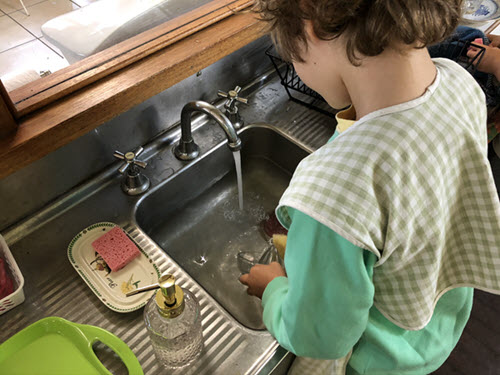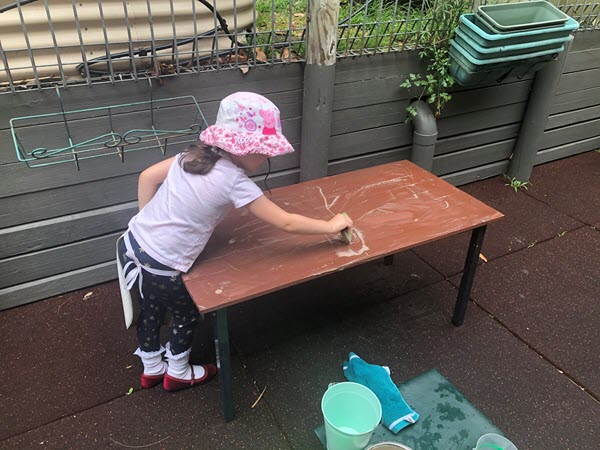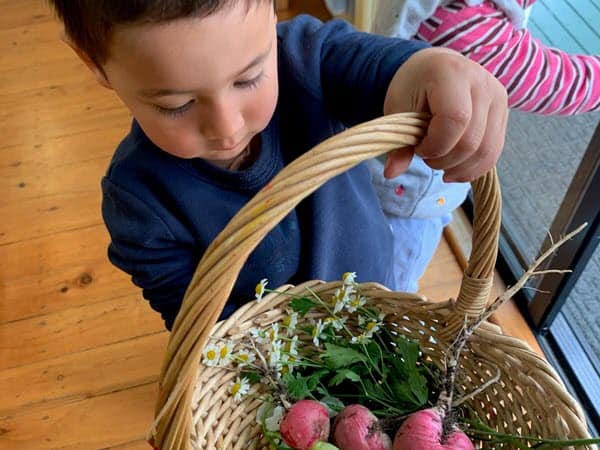As Montessori families, you know how many practical life activities your children engage with each day at school.
Most families are interested in learning how they can continue to develop these practical skills at home. To help, we have prepared this simple-to-follow list, broken down according to room/location within the home. It is ideal for families with toddlers (2-3 years) and young children, up to 6 years old.
Some of the most important aspects of a child’s personality and intellect develop through participation in the everyday life of the family. They are order, sequence, independence, self-control, self-respect, and the joy of learning and accomplishing something purposeful.
Careful set up of your home, and actively assigning appropriate tasks will help set your child up for success! We encourage you to use the guide below and work with your child to grow their confidence, skills, independence and accomplishment throughout your home.

Bedroom set up
- Low clothes rack and hooks in closet
- Place for boots, snowsuits, coat, shoes, etc
- Place to hang up clothes for each day
- Bed that a child can enter and exit by themselves
- Toy shelves — low and in a neutral color. Shelves are preferred over a toy box because they attractively display the toys
- Child-sized table and chairs
- Shelf for books
Bathroom set-up
- Mirror at child’s eye level
- Toothbrush and comb within reach
- Towel, washcloth, towel rack within child’s reach
- Steps at sink so child can turn on tap and wash hands
Kitchen set up
- Child’s own chair at the table
- Small pitcher with small glasses available so child can serve themselves water, milk, juice, etc.
- Sponges and towels at child’s level so your child can wipe up their own spills
- Low drawer that contains any materials necessary for actively participating in the care of the home environment.
Activities a small child can easily perform in the home environment

Pouring
Material: Small attractive pitchers. Child can pour milk, juice, and water for him/herself and others. The first pitcher should contain only as much as the glass or cup 2/3 full; later pitcher can contain more than one glass will hold.
Scrubbing sinks
Materials: a sponge, a small can of cleanser with only one hole uncovered. (CAUTION: The cleanser should be stored out of the child’s reach.) In the first stage, the adult applies the cleanser, the child turns on the tap and scrubs the sink with a sponge. Later the child applies the cleanser under adult supervision and then carries out the activity as above.

Setting table
Child helps put out dishes and silverware and carries them to the table one item at a time. Later, adult sets one place as an example and child sets a place for each family member. Finally child sets table by him/herself, counting out each thing they will need. Of course, items should be put down within child’s reach.
Sponging off plastic tabletops and countertops
Material: Small sponge. Show child how to wet and wring out sponge from a tap. Child carefully sponges off counters, etc, putting crumbs in a pile or sweeping them into his/her hand

Dusting
Materials: Pretty flannel cloths, a small baby’s hairbrush, some place to put the dirty cloths.
Call the child’s attention to the dust. Ask them if they would like to be a helper. Show them how to wrap the cloth around their fingers and wipe away the dust in slow careful strokes, changing position of the dust cloth on their fingers as they notice dust collecting. The brush is used for carved furniture, nooks, and crannies. Child can dust furniture tops, legs, baseboards, corners, ornaments, etc.
Vacuuming
Material: a vacuum cleaner. Many children love to run vacuums. Show your child how to connect the parts of the vacuum. (CAUTION: make it very clear that an adult is to plug it in.) Show the child how to turn it on and off and how to clean different parts of the rug.
Sweeping
Material: small broom, brush, dustpan. Show child how to sweep dirt into a pile with the broom. It is helpful to make a square with masking tape on the floor so the child has a designated spot for the pile. Hold dustpan and sweep dirt into it with the little brush. Carefully carry the dustpan to wastebasket and empty it. Wash off dustpan.
Helping to unload groceries
Put bags on floor. Let child hand you things and put away things at their own level. CAUTION: Some cans are too large to be lifted safely by a child.

When your child performs an activity to help care for themselves or the home environment, thank them regardless of the result. While it’s unlikely to be perfect, and may even be messy, this is the process of learning and gaining independence.
We hope this helps you bring some Montessori into your household. If you have some strategies you would like to share with our community, please do below. If you are interested in further resources or support, feel free to contact our school.



